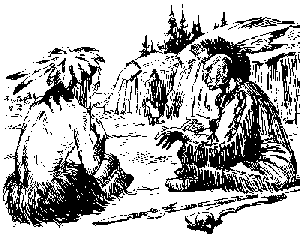WYANDOT ("Huron")
The first contact with the Wyandot tribe was made by French explorer Jacques Cartier in 1536-43. He found them living on the present site of Montreal and Quebec, Canada.
 |
The French started calling them "Huron" about 1600, noting that the roached hair of the warriors looked like the head of a wild boar (French word: "hure"), a name that the Wyandots (themselves) never accepted.
At the time of the first contact in the 1500's, the tribe was locked in a war of extermination with the Iroquois Tribes of Five Nations, which led to their defeat in in 1649. The Wyandots fled westward -- some going to the headwaters of Lake Michigan, others finding refuge with the Potawatomi at Green Bay.
In the early 1700's, the war chief, Orontony, led a conspiracy with many of the midwestern tribes, including the Ottawa, Potawatomi, Sioux, Sauk, Fox Shawnee and Miami, against the French. When his villages and fortifications were destroyed in 1748, the conspiracy was broken. Those residing in the Detroit/Sandusky areas were thereafter known as the Wyandot Tribe. Because of their treaties with them, the Wyandot and many of the tribes sided with the British in the American Revolution, but their alliances were divided in the War of 1812.
They were described by the missionaries as fine agriculturists, who grew crops of tobacco, corn, beans, squash and sunflowers. From the seed of the sunflower they extracted an oil that they used extensively.
The tribal government was unique and quite advanced. The women voted to choose the executive officers, who were then organized into both legislative and judicial councils. The title of the several levels of chieftaincy was hereditary, the candidates being chosen by the mothers of their family.
The Wyandot claimed part of Indiana and the greater part of what is now Ohio. Beginning in 1795 they ceded their lands to the United States, the last being in 1843 when they were removed to a 148,000 acre reservation that they purchased from the Delaware. The land was located in the eastern part of what is now Wyandotte County, Kansas. Intermarriages in both Ohio and Kansas with the white race introduced many anglo names into the tribal rosters, most notably the names of prominent mixed blood families of Armstrong, Clark, Hicks, Northrup and Walker.
Title to the land was assigned to them individually in 1855, but these people (as most of the other tribes) had never before "owned" land-- it was always held by the tribe for their common use and protection -- and ownership could only be transferred by treaty. They did not realize that now they could lose their lands by a simple "X" on a piece of paper. The unending tide of white immigration into Kansas and the inequality of Kansas law caused to them to sink to improvisation.
Fifty years before the Wyandot had befriended the needy Seneca tribe in Ohio and granted them 40,000 acres of the Wyandot land. In 1857 a band of 200 impoverished Wyandots came to Indian Territory. The Senecas, remembering the Wyandot's kindness in their time of need, assigning the emigrants 33,000 acres across the north side of the Seneca reservation in the Quapaw Agency Lands, where many of their descendants live today.
Other information on the Wyandotte tribe can be found at the Kansas History site and the Wyandotte Nation - Oklahoma site.
If you have data to contribute or would like to help with this site, please contact me.
Home
Linda Simpson
Updated: 6 May 2006
Visitor: [an error occurred while processing this directive].
©1999 - 2006 OKGenWeb
All Rights Reserved